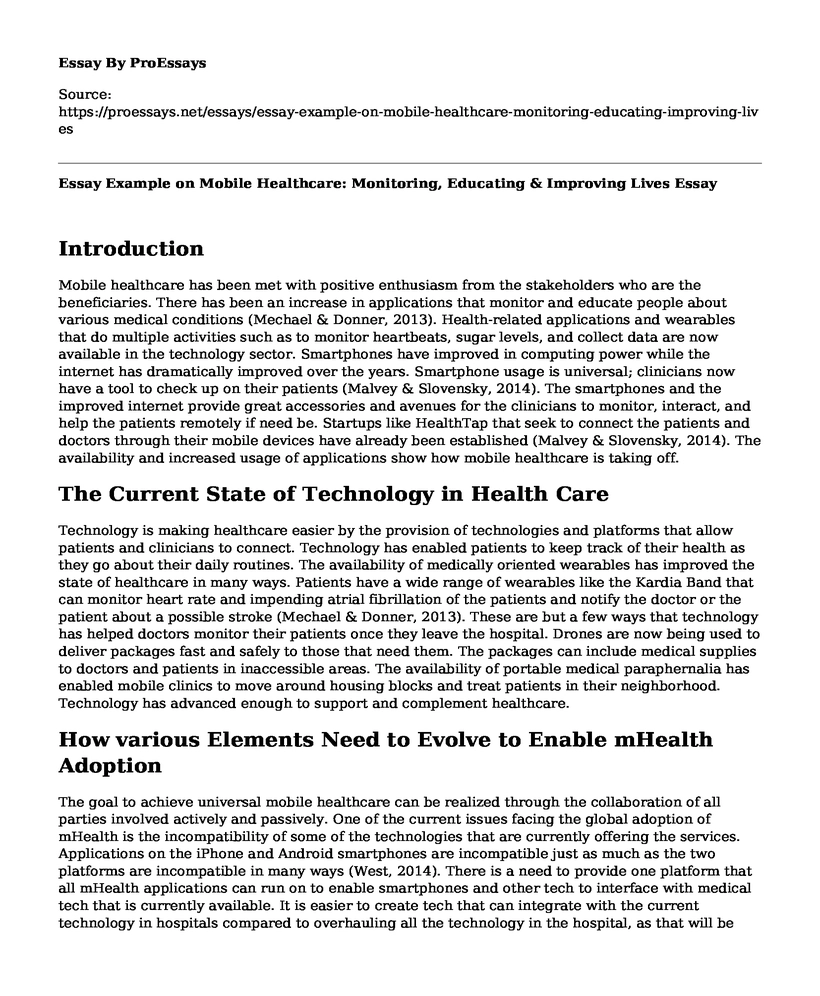Introduction
Mobile healthcare has been met with positive enthusiasm from the stakeholders who are the beneficiaries. There has been an increase in applications that monitor and educate people about various medical conditions (Mechael & Donner, 2013). Health-related applications and wearables that do multiple activities such as to monitor heartbeats, sugar levels, and collect data are now available in the technology sector. Smartphones have improved in computing power while the internet has dramatically improved over the years. Smartphone usage is universal; clinicians now have a tool to check up on their patients (Malvey & Slovensky, 2014). The smartphones and the improved internet provide great accessories and avenues for the clinicians to monitor, interact, and help the patients remotely if need be. Startups like HealthTap that seek to connect the patients and doctors through their mobile devices have already been established (Malvey & Slovensky, 2014). The availability and increased usage of applications show how mobile healthcare is taking off.
The Current State of Technology in Health Care
Technology is making healthcare easier by the provision of technologies and platforms that allow patients and clinicians to connect. Technology has enabled patients to keep track of their health as they go about their daily routines. The availability of medically oriented wearables has improved the state of healthcare in many ways. Patients have a wide range of wearables like the Kardia Band that can monitor heart rate and impending atrial fibrillation of the patients and notify the doctor or the patient about a possible stroke (Mechael & Donner, 2013). These are but a few ways that technology has helped doctors monitor their patients once they leave the hospital. Drones are now being used to deliver packages fast and safely to those that need them. The packages can include medical supplies to doctors and patients in inaccessible areas. The availability of portable medical paraphernalia has enabled mobile clinics to move around housing blocks and treat patients in their neighborhood. Technology has advanced enough to support and complement healthcare.
How various Elements Need to Evolve to Enable mHealth Adoption
The goal to achieve universal mobile healthcare can be realized through the collaboration of all parties involved actively and passively. One of the current issues facing the global adoption of mHealth is the incompatibility of some of the technologies that are currently offering the services. Applications on the iPhone and Android smartphones are incompatible just as much as the two platforms are incompatible in many ways (West, 2014). There is a need to provide one platform that all mHealth applications can run on to enable smartphones and other tech to interface with medical tech that is currently available. It is easier to create tech that can integrate with the current technology in hospitals compared to overhauling all the technology in the hospital, as that will be costly.
The information provided by the patients is and has always been of utmost importance and provided in doctor-patient confidentiality. The transmission and storage of such sensitive information is a matter that needs to be addressed from the start. All the necessary players in the various industries have to provide strict security and privacy controls. This also covers the mobile clinics that will be out in the field. Data and communication channels have to be encrypted and protected by available data protection laws and procedures (Mechael & Donner, 2013). The law has to provide regulations to punish anyone who benefits illegally from the patients' information. The government, on the other hand, has to offer incentives to the mHealth related businesses to help the service attain universal coverage (Mechael & Donner, 2013). The government can give better remuneration to mobile healthcare workers to motivate others to volunteer. Government backing will go a long way in decreasing any trust issues people may have about the mHealth service.
References
Malvey, D. M., & Slovensky, D. J. (2014). mHealth: Transforming healthcare. New York: Springer.
Mechael, P., & Donner, J. (2013). mHealth in practice: mobile technology for health promotion in the developing world. London: Bloomsbury Academic.
West, D. M. (2014). Going Mobile: How Wireless Technology is Reshaping Our Lives. New York, NY: Brookings Institution Press.
Cite this page
Essay Example on Mobile Healthcare: Monitoring, Educating & Improving Lives. (2023, Mar 13). Retrieved from https://proessays.net/essays/essay-example-on-mobile-healthcare-monitoring-educating-improving-lives
If you are the original author of this essay and no longer wish to have it published on the ProEssays website, please click below to request its removal:
- Dental Hygiene: Preventive Counselling Competency
- Benner's Novice to Expert Theory - Article Analysis Essay
- Research Paper on Social Work Planning a Needs Assessment
- Essay Sample on Nutritional Risks the Client (Pregnant Mother)
- Essay Example on Maintain Ideal BMI for Health: 3 Strategies
- Essay Sample on COVID-19 Mask Debate: New York Citizens Split on Political Issue
- Paper Example on Effect of Physical Activity on Young People's Depression: A Meta-Analysis







